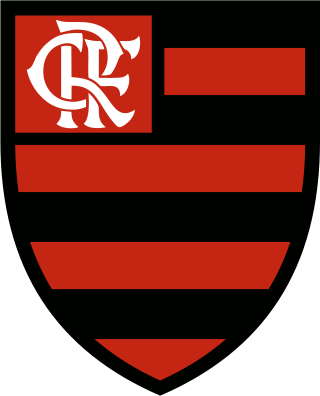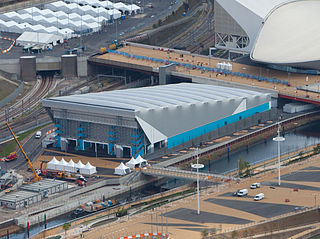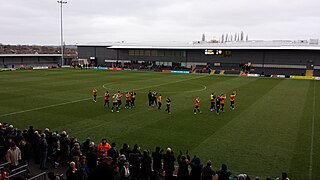
A stadium is a place or venue for (mostly) outdoor sports, concerts, or other events and consists of a field or stage either partly or completely surrounded by a tiered structure designed to allow spectators to stand or sit and view the event.

Omni Coliseum was an indoor arena in Atlanta, Georgia, United States. Completed in 1972, the arena seated 16,378 for basketball and 15,278 for hockey. It was part of the Omni Complex, now known as the CNN Center.

London 2012 was the successful bid to host the 2012 Summer Olympics, held in London with most events taking place in Stratford in the borough of Newham. The British Olympic Association had been working on the bid since 1997, and presented its report to government ministers in December 2000.

CHI Health Center Omaha is an arena and convention center in the central United States, located in the North Downtown neighborhood of Omaha, Nebraska. Operated by the Metropolitan Entertainment & Convention Authority (MECA), the 1.1-million-square-foot (100,000 m2) facility has an 18,975-seat arena, a 194,000 sq ft (18,000 m2) exhibition hall, and 62,000 sq ft (5,800 m2) of meeting space.

London Stadium is a multi-purpose outdoor stadium at Queen Elizabeth Olympic Park in the Stratford district of London. It is located in the Lower Lea Valley, 6 miles (10 km) east of central London. The stadium was constructed specifically for the 2012 Summer Olympics and 2012 Summer Paralympics, serving as the track-and-field venue and as the site of their opening and closing ceremonies. Following the Games, it was renovated for multi-purpose use, and it now serves primarily as the home of Premier League club West Ham United.

The London Aquatics Centre is an indoor facility with two 50-metre (164-foot) swimming pools and a 25-metre (82-foot) diving pool in Queen Elizabeth Olympic Park in Stratford, London. The centre, designed by architect Zaha Hadid as one of the main venues of the 2012 Summer Olympics and the 2012 Summer Paralympics, was used for the swimming, diving and synchronised swimming events. After significant modification, the centre opened to the public in March 2014.

The Riverbank Arena was a stadium in the Olympic Park, in Hackney Wick, London, United Kingdom, containing a water-based astroturf.

Queen Elizabeth Olympic Park is a sporting complex and public park in Stratford, Hackney Wick, Leyton and Bow, in east London. It was purpose-built for the 2012 Summer Olympics and Paralympics, situated adjacent to the Stratford City development. It contains the Olympic stadium, now known as the London Stadium, and the Olympic swimming pool together with the athletes' Olympic Village and several other Olympic sporting venues and the London Olympics Media Centre. The park is overlooked by the ArcelorMittal Orbit, an observation tower and Britain's largest piece of public art.
Anthony Andrew Kleanthous is an English businessman and the current chairman of Barnet Football Club. He became the youngest football chairman to enter the Football League when, aged 28, he bought the club in 1994.
The 2012 Summer Olympics and Paralympics venues were mostly located in the host city of London, though some other events required facilities located elsewhere. Between the successful bid and the Olympics and Paralympics themselves, several details and venues changed.

The Sinan Erdem Dome, formerly known as the Ataköy Dome, is a multi-purpose indoor arena that is located in Ataköy, Bakırköy, Istanbul on the European side of Istanbul, Turkey.

The Sydney SuperDome is a large multipurpose arena located in Sydney, Australia. It is situated in Sydney Olympic Park, and was completed in 1999 as part of the facilities for the 2000 Summer Olympics.

The Melbourne Sports Centre – Parkville, previously known as the State Netball Hockey Centre is a multipurpose sporting facility located in Melbourne, Australia. It is the administrative headquarters for both Netball Victoria and Hockey Victoria and features two outdoor hockey fields and several indoor netball courts, each capable of seating up to 8,000 and 3,050 spectators respectively. National Basketball League club Melbourne United played home matches at the venue in the past, as well as Super Netball team Melbourne Vixens, though both clubs have shifted home matches to larger-capacity arenas. Hockey Club Melbourne of the Hockey One league play home games on the main hockey pitch.

Queensland Tennis Centre, known during its development as the Tennyson Tennis Centre, is a tennis venue in Tennyson, Brisbane, Australia. It is an A$82 million tennis facility opened on 2 January 2009 at the site of the demolished Tennyson Power Station.

The Copper Box Arena is a multi-sport venue built for the 2012 Summer Olympics, located in the Queen Elizabeth Olympic Park in London, England.

The Hellinikon Olympic Indoor Arena was a multi-use sports indoor arena that was located in Elliniko, Athens, Greece. It was a part of the Hellinikon Olympic Complex, and it was located adjacent to the Helliniko Fencing Hall. It was approximately 10 miles from the Athens Olympic Village. It was built on the site of the former Hellinikon International Airport for the 2004 Summer Olympics and the 2004 Summer Paralympics.

The Flamengo Basketball team is a professional Brazilian basketball team based in Rio de Janeiro. It is a part of the Clube de Regatas do Flamengo multi-sports club family. The club's full name is Basquetebol do Clube de Regatas do Flamengo. The club's commonly used short names are C.R.F. Basquete, C.R. Flamengo Basquete, Flamengo Basquete, and FlaBasquete.

The Water Polo Arena was a temporary sporting venue of the 2012 Summer Olympics held in London from 27 July to 12 August 2012. It was situated in the south-east corner of the Olympic Park, alongside the Aquatics Centre, and opposite the Olympic Stadium on the opposite bank of the Waterworks River.

The Hive Stadium is a stadium in Canons Park, North London, on the former site of the Prince Edward Playing Fields in the London Borough of Harrow. The stadium is home to National League football club Barnet, London Bees of the FA Women's Championship and formerly Tottenham Hotspur F.C. Women of the FA WSL from 2019–2022.
The MSG Sphere London is a proposed music and entertainment venue to be built in the Stratford area of London, England.






















